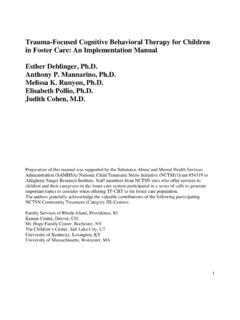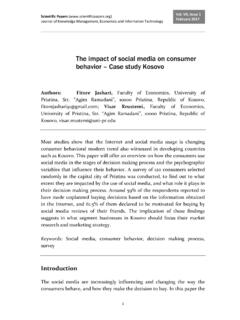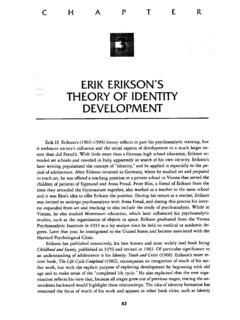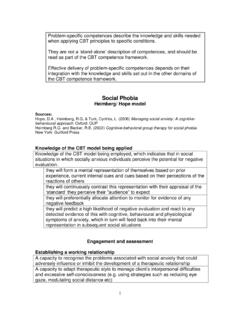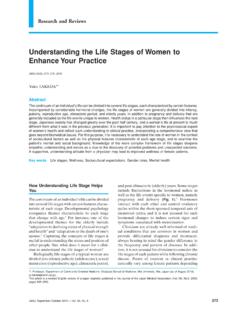Transcription of Trauma-Focused Cognitive Behavioural Therapy for Children …
1 Child and Adolescent Mental Health Volume 13, No. 4, 2008, pp. 158 162 doi: Trauma-Focused Cognitive Behavioural Therapy for Children and Parents Judith A. Cohen & Anthony P. Mannarino Allegheny General Hospital, Center for Traumatic Stress in Children and Adolescents, 4 Allegheny Center, 8th Floor, Pittsburgh, PA 15217, USA. E-mail: Trauma-Focused Cognitive Behavioural Therapy (TF-CBT) for Children and parents is an evidence based treat- ment approach for traumatised Children . Evaluation of TF-CBT includes several randomised controlled trials, effectiveness studies and ongoing studies for Children experiencing sexual abuse, domestic violence, traumatic grief, terrorism, disasters and multiple traumas. The model of TF-CBT described here is a flexible, components- based model that provides Children and parents with stress management skills prior to encouraging direct discussion and processing of Children s traumatic experiences.
2 TF-CBT components are summarised by the acronym PRACTICE: Psychoeducation, Parenting skills, Relaxation skills, Affective modulation skills, Cognitive coping skills, Trauma narrative and Cognitive processing of the traumatic event(s), In vivo mastery of trauma reminders, Conjoint child-parent sessions, and Enhancing safety and future developmental trajectory. Currently this model of TF-CBT is being adapted and implemented both within the USA and internationally. Keywords: Trauma; posttraumatic stress; Children ; adolescents; Cognitive Behavioural Therapy ; parents exposure. These can be divided into problems of affect, Introduction behaviour, and cognition. All too often Children experience traumatic events Affective problems may include sadness, fear, anxiety before reaching adulthood. International studies docu- or anger. Some Children may develop excessive moodi- ment that child sexual abuse, physical abuse or ness, or develop difficulty in controlling or regulating domestic violence affect up to 25% of Children around their moods and emotional states (affective dysregula- the world, with potentially serious and negative effects tion).
3 Affective dysregulation can arise from a variety of lasting into adolescence and adulthood if left untreated causes, and it is important for the therapist to critically (Ammar, 2006; Chen, Dunne, & Han, 2004; Nelson analyse the source of the child s problems. For example, et al., 2002, Xu, Campbell, & Xhu, 2001). Natural a child may feel sad because she is overly responsive disasters, motor vehicle accidents, community and to negative stimuli (her feelings are easily hurt), is school violence are also common, with many Children underresponsive to positive stimuli or does not have being negatively impacted by such exposure. Although adequate skills to access positive stimuli (she doesn t some Children never experience war, terrorist acts or know how to take a compliment , she s too shy to refugee status, many others do. These events are also approach new peers , etc.)
4 These sound like similar potentially traumatic and can result in long lasting problems but may require somewhat different inter- negative emotional sequelae. ventions. Perhaps this child is happy sometimes but While most Children are resilient following trauma later reinterprets that experience more negatively ( exposure, some are not. Recent research suggests that has fun at a friend s house but later says she hated it). genetic makeup influences how Children respond In the above instances, the child s negative feelings were to traumatic events (Caspi et al., 2002). Several other partly related to negative cognitions that are amenable factors can serve as risk or protective factors following to therapeutic interventions. Children s exposure to trauma. These include the degree Behavioural problems may take the form of avoidance of exposure to the index trauma, including threat to the of trauma reminders (any person, place, thing or situ- child s life and threat to or loss of life of family members; ation that reminds the child of the original trauma).
5 The availability of social support; past history of other Avoidance is a hallmark of PTSD, but it is also normal traumas; the child s preexisting history of anxiety for Children to want to avoid talking about painful or disorder; parent s history of psychiatric disorder; the difficult subjects. Thus, it may be hard to distinguish presence of parental posttraumatic stress disorder PTSD avoidance from a child s normal reticence to dis- (PTSD) in response to the index trauma; and the amount cuss an upsetting topic, the irritability associated with of time the child spends viewing television coverage of the depression, or another underlying difficulty. Following index traumatic event (reviewed in Pine & Cohen, 2002). traumatic exposure Children may also develop new oppositional behaviours (which may result from anger The impact of trauma exposure or feelings of betrayal in reaction to the unfairness of Children may develop different types of emotional the traumatic event).
6 Children may develop new diffi- or Behavioural problems in response to traumatic culty in separating from adults (school refusal, wanting 2008 Association for Child and Adolescent Mental Health. Published by Blackwell Publishing, 9600 Garsington Road, Oxford OX4 2DQ, UK and 350 Main Street, Malden, MA 02148, USA. Trauma-Focused CBT for Children and Parents 159. to sleep with parents), regressive behaviours, or other secondary to the traumatic event or events Children manifestations of anxiety. Adolescents may use sub- experienced. No treatment is optimal for everyone, and stances as a way of coping with emotional distress or this treatment is not optimal for Children whose primary avoiding trauma reminders. Another symptom of PTSD problems are not trauma-related. Traumatic events is re-experiencing the original trauma. In some cases happen to Children who have other serious psychiatric this may lead to sexualised behaviour, bullying, or problems, and Children with longstanding Behavioural abuse of others.
7 Problems may have experienced traumatic events, Cognitive problems may include distorted ideas about either in their distant past or recently. For these why the traumatic event happened, who was responsi- Children it is critical to determine whether their trauma ble (including self-blame), shame or worthlessness, symptoms are primary, or their other psychiatric and/or a loss of trust. Children who blame themselves problems will take precedent in their treatment. If the for what happened and feel that they are unworthy of latter is true, it will be important to provide conjoint being loved or of having good things happen to them treatment for the co-existing condition so the TF-CBT. may begin to behave in self-defeating ways. For exam- therapist can focus on the trauma treatment without ple, they may begin to associate with peers who get into being constantly sidetracked by comorbidity issues, or trouble, truant from school, or use drugs, and may start to address and stabilise the comorbid problems before to engage in these behaviours themselves as they the child can adequately address trauma issues believe this is the kind of person I am now.
8 As will be through TF-CBT interventions. Some of these Children discussed below, TF-CBT is largely based on the idea may not have significant trauma symptoms, in which that affect, behaviours and cognitions are interrelated. case a thorough assessment would indicate that It should be clear from the brief discussion above TF-CBT would not be appropriate. This highlights the that traumatic exposure can result in a wide variety of importance of providing a complete Trauma-Focused emotional and/or Behavioural symptoms in Children assessment prior to starting TF-CBT, which should and adolescents. Some Children will develop significant evaluate not only whether the child experienced trauma disorders such as PTSD, depression, or substance use exposure, but to what extent these events are currently disorders, while others will not. The potential impact of impacting upon the child.
9 Children for whom TF-CBT is trauma on Children is discussed in greater detail not appropriate should be referred for an alternative elsewhere (Cohen, Mannarino, & Deblinger, 2006a, pp evidence supported treatment model. 3 19). Treatment components Trauma Focused Cognitive Behavioural Psychoeducation Therapy (TF-CBT). Once the therapist, child and parent agree that TF-CBT. The model of TF-CBT described here is a flexible com- is the right treatment, it is important to educate the ponents-based treatment model that consists of indi- family about this approach. Psychoeducation should vidual child-and-parent treatment sessions, as well as start from the first contact with the family. When a child joint child-parent sessions. Each component is pro- has experienced a traumatic event, parents are under- vided to both the child and parent in parallel sessions; standably distressed, worried, or even overwhelmed parents additionally receive interventions to optimise about what this means for the child s long term prog- effective parenting.
10 The components of TF-CBT are nosis. Providing information in this regard ( that summarised by the acronym PRACTICE. This is par- many Children have mostly transient symptoms and ticularly appropriate since we hope that Children and recover well following trauma exposure) can provide an parents will practise what they learn in Therapy between important message of hope before the family even treatment sessions. A core principle of the TF-CBT comes to the initial assessment. At the initial assess- model is the use of gradual exposure . Each TF-CBT ment, information about the child s diagnosis and the component includes graded exposure to the child s treatment plan ( the TF-CBT treatment model). traumatic experience; the intensity of the exposure should be introduced. Psychoeducation continues incrementally increases as the child and parent throughout treatment by providing information about systematically move through the hierarchy.



